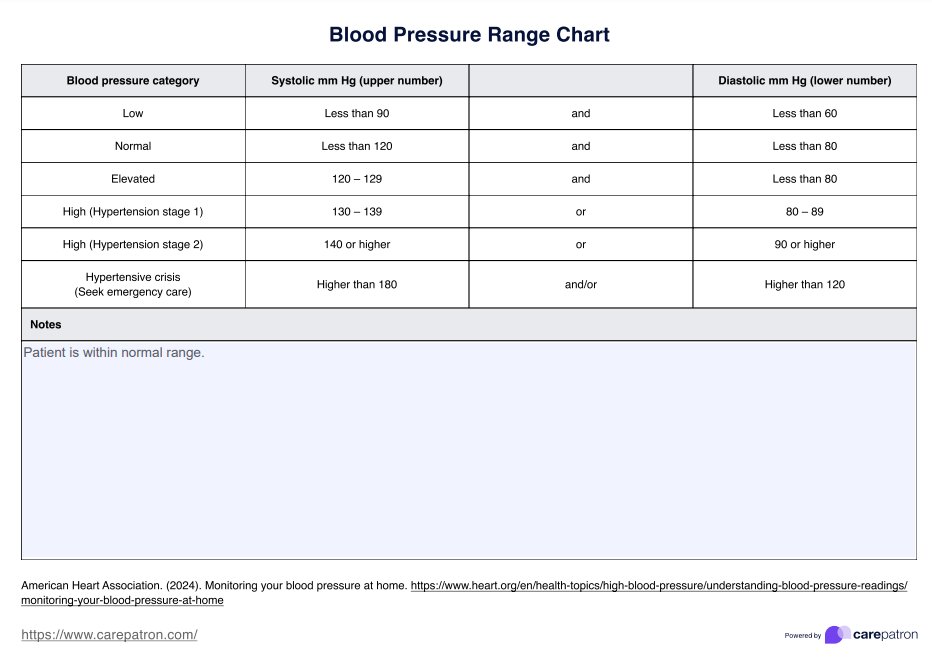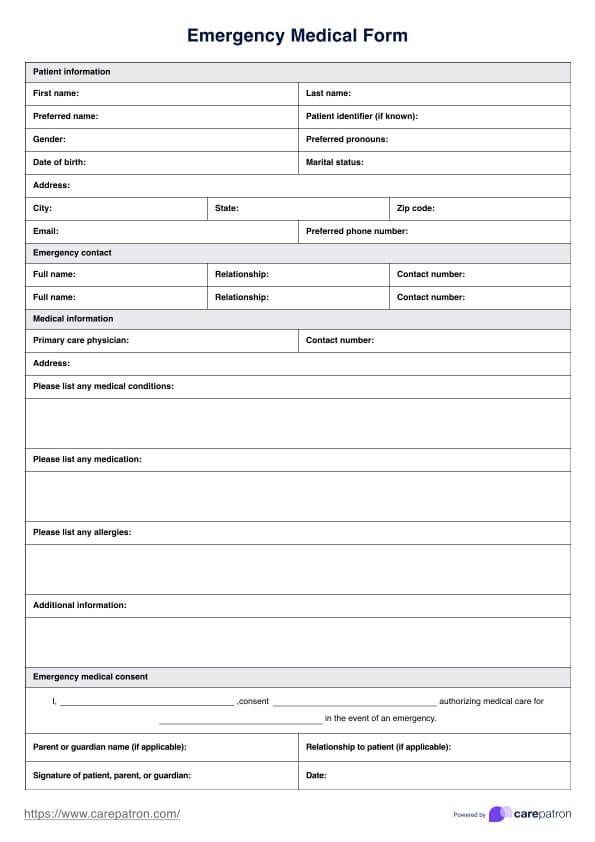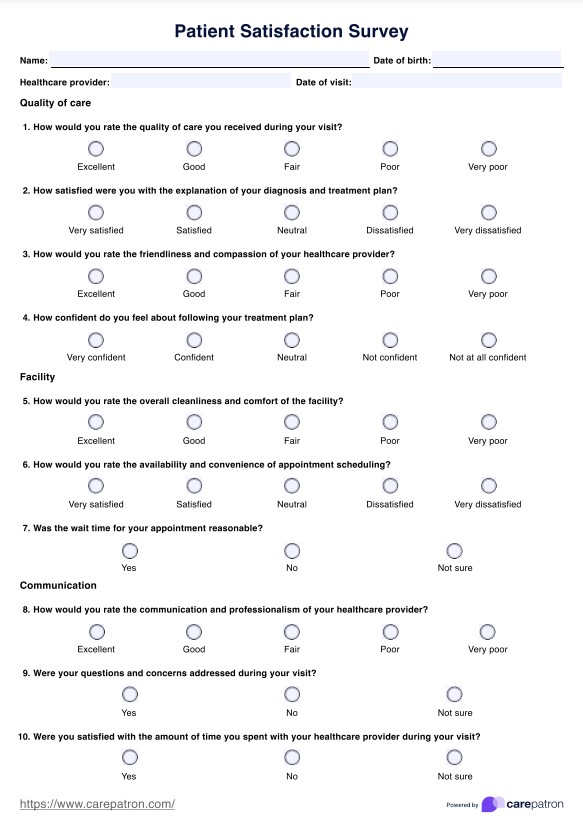Blood Pressure Range Chart
Learn about the different blood pressure ranges and download our Blood Pressure Range Chart PDF template.


What is blood pressure?
Blood pressure is an essential component of our circulatory system. This pressure is the force that our blood exerts when pushing against our arterial walls. This pressure is vital to our hearts because it helps them pump blood throughout our bodies.
There are two kinds of blood pressure: systolic and diastolic. Systolic pressure is the pressure in our arteries whenever our hearts beat, while diastolic pressure is the pressure in our arteries whenever our hearts are resting between beats. Systolic Blood Pressure will always be higher than Diastolic Blood Pressure.
Both types need to be at an optimal level. If blood pressure is higher or lower than the optimal level, it’ll cause problems, primarily if it isn’t addressed as soon as possible.
If a person has a blood pressure higher than the optimal level, it’s called hypertension. If left untreated, high blood pressure puts a person at risk of developing dangerous serious health problems, specifically heart problems, like strokes (sometimes referred to as cerebral infarctions), heart disease, heart failure, and kidney problems
If a person's blood pressure is lower than the normal blood pressure level (hypotension), it’s not automatically a cause for concern. Still, it can cause unwanted problems, especially the more it dips. Examples of such situations include dizziness, lightheadedness, fatigue, and lethargy. At worst, it can cause shock and fainting.
Blood Pressure Range Chart Template
Blood Pressure Range Chart Example
How to use our Blood Pressure Range Chart
Our Blood Pressure Range Chart or blood pressure chart is essential for healthcare professionals to assess and monitor a patient’s blood pressure levels. This chart helps identify the different ranges which are critical to identify and diagnose high blood pressure, elevated blood pressure, and even low blood pressure.
Step 1: Determine the patient's baseline blood pressure
The first step is to establish the patient’s baseline blood pressure. This involves taking multiple readings at different times to get an accurate average. It’s crucial to ensure the patient is relaxed and seated for at least five minutes before taking the measurement.
Step 2: Use proper technique for accurate measurement
Accurate blood pressure measurement is crucial. Ensure the blood pressure cuff fits correctly and the patient's arm is at heart level. Use a validated and calibrated sphygmomanometer or digital blood pressure monitor for the readings.
Step 3: Compare readings with the chart
Once you have the readings, compare them with the Blood Pressure Range Chart values on the template, which you can download by clicking the "Use Template" button. This comparison will help categorize the patient's blood pressure as normal, elevated, stage 1 hypertension, or stage 2 hypertension.
Step 4: Consider patient-specific factors
When interpreting the results, consider factors such as the patient's age, medical history, and risk factors for cardiovascular disease. This holistic approach ensures a more accurate assessment and personalized care plan.
Step 5: Advise and plan accordingly
Based on the chart’s categorization, advise the patient on lifestyle modifications, blood pressure medication (if necessary), and follow-up plans. Regular monitoring and adjustments to the care plan may be required based on the patient’s response and changes in blood pressure.
When would you use this Blood Pressure Range Chart template?
The Blood Pressure Range Chart is critical for healthcare professionals across various specialties. Its primary use is in assessing and managing blood pressure, a key indicator of cardiovascular health. Here are some specific scenarios and practitioners for whom this chart is handy:
- General practitioners during routine check-ups: This chart is invaluable for general practitioners during routine health check-ups. It helps quickly assess whether a patient's blood pressure is within a normal range or if further investigation is needed.
- Cardiologists for hypertension management: Cardiologists will find this chart essential in managing patients with hypertension. It aids in categorizing the severity of hypertension and tailoring treatment plans accordingly.
- Nurses in clinical settings: Nurses often perform initial patient assessments, including blood pressure measurements. This chart provides a quick reference for determining whether a patient's readings cause concern.
- Healthcare providers in emergencies: Rapid blood pressure assessment is crucial in emergency medical situations. This chart helps emergency healthcare providers determine if a patient's blood pressure is dangerously high or low.
- Specialists managing chronic conditions: This chart is a handy reference for specialists managing chronic conditions like diabetes or kidney disease, where blood pressure control is vital.
The Blood Pressure Range Chart is an indispensable resource for many healthcare professionals, whether they measure blood pressure at home, in the clinic, or elsewhere. It plays a crucial role in the early detection and ongoing management of blood pressure-related conditions, ultimately contributing to better patient outcomes.
Common blood pressure readings
Understanding the results of the Blood Pressure Range Chart is critical to effective patient management. Here's a brief overview of what common blood pressure readings indicate:
- Normal blood pressure: Readings in this range suggest good cardiovascular health. Regular monitoring is still recommended to maintain healthy blood pressure levels.
- Elevated blood pressure: This indicates a higher risk of developing hypertension. Lifestyle modifications and regular monitoring are usually recommended.
- Stage 1 hypertension: At this stage, medical intervention and lifestyle changes might be necessary. It indicates a higher risk of cardiovascular diseases.
- Stage 2 hypertension: This is a more severe form of high blood pressure and often requires immediate medical treatment. It significantly increases the risk of heart disease and stroke.
- Hypertensive crisis: Extremely high readings require immediate medical attention. This is a critical condition that can lead to life-threatening complications.
The Blood Pressure Range Chart helps healthcare professionals diagnose hypertension and understand its severity. This understanding is crucial for determining the appropriate action, lifestyle changes, medication, or more urgent medical interventions. Proper interpretation of these results is essential for effective patient care and managing blood pressure-related health risks.
Commonly asked questions
Having a family history of hypertension and cardiovascular problems, drinking alcohol, smoking, being obese, high sodium diets, and not exercising.
Dehydration, Parkinson’s Disease, irregular heart rhythms, recreational drugs, alcohol, extreme cold temperature, and being pregnant, to mention a few.
By exercising regularly, having a healthy and balanced diet, limiting or avoiding alcohol, avoiding smoking, and learning how to manage their stress properly.















































































































